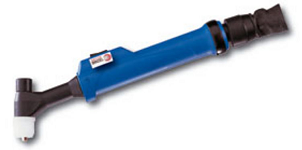The process of ‘blanking’ or cutting the flat pattern from a sheet metal can be achieved by a variety of methods. In this posting we will take a look at some of the most common types of sheet metal cutting. When determining which method of sheet metal cutting is right for you you should take into consideration the factors of flexibility, speed, accuracy, finish, cost and automation. There are certain considerations when it comes to the material you’re cutting so we’ve added a specific post on how to cut aluminum.
Hand Tools
Cost : $20 – $100
Flexibility : Low
Speed : Very Slow
Accuracy : Very Low
Finish : Poor
Automation : None
Chisel and Hammer
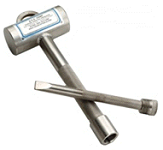
Using a chisel and hammer is the most basic form of cutting sheet metal. Simply line up your chisel along the line you are going to cut and strike the back of it with a hammer. If you’ve hit it hard enough the chisel will cut the sheet metal if it’s thin enough. A soft wood backer will allow for the chisel to pass through more easily by providing support for the metal. This process of cutting is very slow and labor intensive. It may be appropriate if you’re working on a little project in your garage and you have the time available to clean up the sharp deformed edges when you are done cutting. The accuracy of the cut is going to come down to how patient you are when lining up the chisel. You’ll also be limited to the gauges you can work with, I don’t believe you’ll be cutting anything thicker than 16 gauge cold rolled steel with this method.
Snips
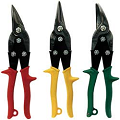
Aviation snips and tin snips are a common method of cutting thin sheet metal for hobbyists. These tools are good for cutting soft sheet metals such as tin, aluminum and brass. You probably wont find snips which are capable of cutting above 18 gauge mild steel. For a reference on gauge thickness see our gauge chart. When working with curved pieces on a small project these snips can definitely come in handy. Aviation snip is a term applied to the higher end form of this sheet metal cutting tool which comes in 3 basic varieties allowing for straight, left hand curved and right hand curved cuts. For most applications it is necessary to file and clean up the edges left by a snip. When you’re using these tools it’s good practice to keep the top blade seated on the metal while you ‘pull’ the bottom blade towards you. Open the snips all the way at the beginning of a cut and seat the sheet metal as deep as possible into the opening, this provides you with maximum leverage. For cutting out holes in sheet metal it’s going to be necessary that you begin with a starter hole, this can be formed by using the hammer and chisel method to punch through the metal. Once you have the starter hole work your way out to the desired radius using the correct red or green colored snip.
Hacksaw
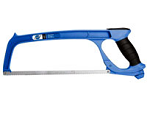 Hacksaws or jeweler’s saws are another basic hand tool which can be used to cut sheet metal. You are limited in turning radius and depth because of the geometry of a hack saw. The hacksaw lends itself towards the softer metals because the harder ones such as stainless steel tend to eat blades so, again, these tools are suited for hobbyists or small sheet metal shops. Choosing the right blade for the material you are cutting is essential to the success of this method. Typically you’ll be choosing a ‘wavy’ type of tooth setting which is designed to make clean cuts in thin hard material such as sheet metal. Adding cutting compounds or simply wax can improve the life of your blade and the quality of the cut. Putting a strip of masking tape on the front and back of th sheet metal can help improve the cut by reducing the number of chips, but ultimately the accuracy and finish is up to the operator.
Hacksaws or jeweler’s saws are another basic hand tool which can be used to cut sheet metal. You are limited in turning radius and depth because of the geometry of a hack saw. The hacksaw lends itself towards the softer metals because the harder ones such as stainless steel tend to eat blades so, again, these tools are suited for hobbyists or small sheet metal shops. Choosing the right blade for the material you are cutting is essential to the success of this method. Typically you’ll be choosing a ‘wavy’ type of tooth setting which is designed to make clean cuts in thin hard material such as sheet metal. Adding cutting compounds or simply wax can improve the life of your blade and the quality of the cut. Putting a strip of masking tape on the front and back of th sheet metal can help improve the cut by reducing the number of chips, but ultimately the accuracy and finish is up to the operator.
Hand Shear
Disk blade shears are a European tool which is basically an open mouthed can opener. Good for tight corners but leaves a grooved edge which may need to be cleaned. Can cut up to 16 gauge mild steel by hand.
Bench Tools
Cost : $100 – $1000
Flexibility : Medium – Low
Speed : Slow
Accuracy : Low
Finish : Poor
Automation : None
Straight Bench Shears
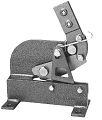
These bench mounted shears convert leverage into a compact scissor which is capable of cutting medium gauge sheet metal. It will primarily limit your cuts to straight lines. These types of shears lend themselves towards hobbyists and sheet metal shops doing custom or repair work. They are rugged and will last a lifetime if kept clean and sharp.
Beverly Throatless Shears

Known for its manufacturer’s name this shear is common in small sheet metal shops because of its versatility in cutting sheet metal of varying gauges and patterns. Other throatless shears are available from other manufacturers and have the same basic features and limitations. With some fine tuning of the blade spacing the edge left by this type of shear is significantly improved over that of hand shears because it does not distort the edge and will actually round the top edge slightly. Coming in three sizes, B1, B2 and B3 depending on the size and power required.
Band Saw
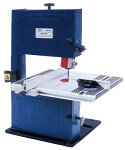
Band saws will over a bit of a mixed bag when it comes to cutting sheet metal. They are limited by their bed design in terms of what size sheet you can cut so make sure you understand your saw’s limitations before laying out a flat pattern. Good for softer materials because of the blades they can be useful in select applications. The edge left by them often will need some cleaning.
Stationary Nibbler
These machines are basically a single tool C-Frame Punch Press which can be used to chip away at sheet metal. They cut a wide kerf away from the metal and leave a serrated edge which almost always needs secondary processing. When cutting they also eject the small crescent shaped drops which need to be collected and handled carefully.
Power Tools
Cost : $75 – $300
Flexibility : Medium
Speed : Medium
Accuracy : Low
Finish : Mixed
Automation : None
Angle Grinders
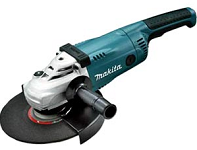
Also known as Makita’s for a common manufacturer, the angle grinder is a versatile tool used in many sheet metal shops. Capable of cutting relatively heavy gauges when compared to hand and bench tools it has the added advantage of being hand held and portable.
Power Shears
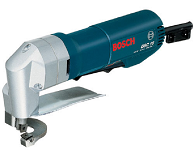
Electric shears and double cutters are another common site in sheet metal shops which do small job shop types of cutting. These hand held tools are basically portable micro shears which chew away at the metal as you maneuver the cutting blade along its intended path. A throatless design allows you to cut into the sheet without worrying about the back of the tool. Their major draw backs are noise, vibration and edge quality. They require a strong hand to drive the cutting blades accurately and will shake the sheet if it is not held down properly. Because the power shears make a large number of small cuts in the sheet metal it can leave a dangerous serrated edge which needs to be cleaned before it’s safe for handling.
Electric Jigsaw
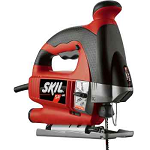
Handheld jigsaws provide a very mixed bag when it comes to cutting sheet metal. The right combination of a high quality saw and high quality blade can result in a good consistent cut and decent turning radius. The wrong blade for the material and a cheap saw will lead to a frustrating and dangerous cutting environment. Because jig saws are throatless by design they do over some versatility in the shop.
Nibbler
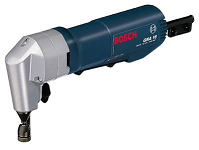
A similar type of machine to the power shears these machines punch out a section of the material as they move essentially nibbling away at the metal as the operator guides them. They are not often liked in shops because of their wide kerf and the sharp crescent shaped pieces of drop they eject when cutting sheet metal.
Heat Cutting
Cost : $200 – $900
Flexibility : Medium
Speed : Medium – High
Accuracy : Low
Finish : Poor
Automation : None
Oxygen / Acetylene Torch
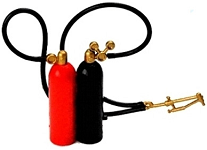
Gas torches such as these work well with steel because their burn temperature is lower than their melting temperature. The heat from the torch combined with a steady stream of oxygen rapidly oxidizes the sheet metal and blows the weakened metal away. This creates a lot of heat and sparks but can cut thick steel and move at a relatively high speed. The torch doesn’t need any sort of backing and is portable, which makes it ideal for working in difficult to reach spaces. You have to take into account the cost of the gas when pricing these machines out. In addition special sheet metal cutting tips are available for specific metals and thicknesses. These torches can also be used to anneal the metal which has its advantages in a custom shop.
Plasma Torch
The plasma torch works similarly to an oxy-acetylene torch however instead of oxidizing the metal the plasma ionizes it with a strong electro magnetic field. In addition to the heat from the torch this weakens the sheet metal under the torch and allows it to be blown away with high pressure air. The plasma torch is very versatile when it comes to the type of material it can cut and, like the oxy-acetylene torch, it is easily maneuverable along a sheet and in tight places. This makes it a common choice for custom sheet metal shops. The downsides are the amount of sparks it produces, the distance it throws the sparks and the edge it leaves. Only work with this torch in an area where you know the spark direction and where there is nothing flammable around it. You will definitely have to clean the edge after cutting.
Industrial Cutting
Cost : $10,000 – 5,000,000+
Flexibility : Very High
Speed : Very High
Accuracy : Very High
Finish : Excellent
Automation : Many Options
Plasma
A CNC controlled plasma bed is basically the cheapest form of industrial cutting available. Slower than its counterparts it is basically just a plasma torch mounted on an automated gantry. While versatile in terms of materials and thicknesses its main advantage is price.
Water Jet
Water jet machines focus a very thin stream of water mixed with abrasives at extraordinary pressures and very high speed into the sheet metal. This eats away at the metal and leaves a very clean and smooth edge. Water jets are surprisingly capable of cutting very thick sheet metal, up to a few inches thick with very high accuracy. Their main advantages are the finished edges, variety of materials and accuracy. A slightly rounded edge with smooth faces allows for safe handling right off of the machine. Because there is no chemical or electrical or heat interaction with the metal water jets can cut almost any metal, plastic, alloy or material with the same accuracy and finish.
Punch Press
Punch presses use shaped tools to knock out geometry in sheet metal. Larger presses can be loaded with dozens of different types of tools for special cutting and forming. They are not typically as quick as lasers but they offer the ability to stamp, roll and form the metal while cutting. This allows for the formation of louvers, jogs,beads, and impressions which lasers cannot form. They are also typically cheaper on the front end when compared to lasers however there are maintenance costs associated with the tooling.
High powered lasers offer the fastest most accurate form of sheet metal cutting. Modern lasers move the cutting head over the sheets at very high speeds with incredible accuracy. While limited to 2D cutting their accuracy and speed is un-paralleled. With proper tuning and adjusting of the laser a clean safe edge can be achieved. Though very expensive they are a must have for a modern sheet metal shop.
